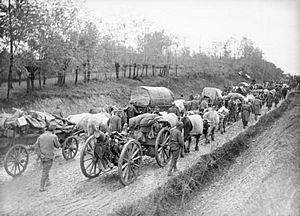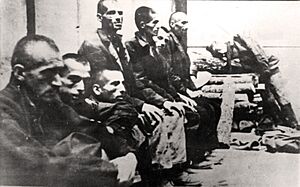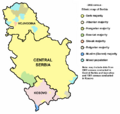History of the Serbs facts for kids
The History of the Serbs tells the story of the Serb people from ancient times to today. Serbs are a South Slavic group who mostly live in Serbia, Montenegro, Bosnia and Herzegovina, Croatia, and North Macedonia. Many Serbs also live in other parts of the world, like Western Europe, North America, and Australia. This is known as the Serbian diaspora.
Contents
Middle Ages


Slavic people moved into the Balkans during the 500s and 600s. Here, they met and mixed with the people already living there. Serbs were one of these early Slavic groups. An old book called De Administrando Imperio, written by the Byzantine emperor Constantine VII, says that Serbs moved from a place called White Serbia to the Balkans around the 600s. They first settled near Thessaloniki but then moved to lands between the Sava river and the Dinaric Alps.
By the late 600s, some Serb settlers in a region called Bithynia were already Christians. Their city, Gordoserba, even had its own bishop. This shows that Christianity was spreading among the Serbs.
After settling in the western Balkans, Serbs created their first state, the early medieval Principality of Serbia. This state was ruled by the Vlastimirović dynasty. During their time, Serbs slowly became Christians, a process that finished by the mid-800s. Serbs also formed smaller local states in areas like Neretvanija, Zahumlje, Travunija, and Duklja.
In the 1000s and 1100s, the Grand Principality of Serbia was led by the Vukanović dynasty. During this time, Serbs often fought against the powerful Byzantine Empire next door.
Between 1166 and 1371, the Serbs were ruled by the Nemanjić dynasty. This family was started by Grand Prince Stefan Nemanja (1166-1196). He took over several nearby lands, including Kosovo and Duklja. The Serbian state became a kingdom in 1217, under Nemanja's son, Stefan Nemanjić. Around the same time, the Serbian Orthodox Church became independent in 1219, thanks to Sava. He is now a very important saint for Serbs.
Over the next 140 years, Serbia grew bigger. Its culture was still very much like the Byzantine Empire. Serbia's power reached its peak during the rule of Stefan Dušan, who ruled from 1331 to 1355. In 1346, he was crowned emperor, creating the Serbian Empire. The Serbian Orthodox Church also became a Patriarchate in 1346. The Empire included lands like Macedonia, northern Greece, Montenegro, and most of Albania.
When Dušan died, his son Stephen Uroš V became emperor. In the 1350s, Turkish invaders, the Ottomans, began conquering the Balkans. A big fight started between them and the Serbs. The first major battle was the Battle of Maritsa in 1371, where the Serbs were defeated. After this battle, and with the death of Emperor Stephen Uroš that same year, the Serbian Empire broke into several smaller Serb states. These states were ruled by local lords.
In 1389, the Serbs faced the Ottomans again at the Battle of Kosovo. This battle took place on the plain of Kosovo Polje, near Pristina. Both the Serb leader Lazar and the Ottoman Sultan Murad I were killed. The battle likely ended in a draw, and Serbia did not fully fall to the Ottomans until 1459.
Early Modern Period
Serbs actively fought in wars against the Ottoman Empire in the Balkans. They also organized uprisings. Because of this, they faced harsh treatment, and their lands were destroyed. Many Serbs moved from Serbia to lands controlled by the Habsburg Empire. Ottoman rule in Serbia lasted from the late 1400s to the early 1800s. This period was sometimes interrupted when the Habsburgs took control during their wars with the Ottomans.
In early 1594, Serbs in Banat rose up against the Ottomans. The rebels carried war flags with the image of Saint Sava, seeing it as a holy war. After putting down the uprising, the Ottomans publicly burned the relics of Saint Sava on April 27, 1595. This act made Serbs even more determined to fight for freedom. From 1596, the Tvrdoš Monastery in Trebinje became a center for anti-Ottoman activities in Herzegovina. Another uprising broke out in 1596, but the rebels were defeated and had to give up because they lacked outside help.
In 1686, Christian forces captured Buda from the Ottomans during the Great Turkish War. Serbs from the Pannonian Plain joined the Habsburg army as separate units. Many Serbs volunteered to fight on the Austrian side. In 1688, the Habsburg army took Belgrade and entered what is now Central Serbia. Louis William, Margrave of Baden-Baden asked Serbian Patriarch Arsenije III Čarnojević to encourage Serbs to fight the Turks. The Patriarch agreed.
A large number of Serbs then moved to Habsburg lands, led by Patriarch Arsenije III. This big community of Serbs settled in Banat, southern Hungary, and the Military Frontier. They included merchants, craftsmen, and many peasant refugees. Smaller groups of Serbs also moved to the Russian Empire, where some held important military positions. Serbia remained under Ottoman control until the early 1800s, when the Serbian Revolution began in 1804.
Modern Period

19th Century
The Serbian uprising ended in the early 1830s. Serbia gained self-rule, its borders were set, and Miloš Obrenović became its ruler. The last Ottoman troops left Serbia in 1867. However, Serbia's full independence was not recognized by other countries until the Congress of Berlin in 1878. When the Principality of Serbia became independent, the Orthodox Christian faith became very important in defining Serbian national identity.
20th Century
Serbia fought in the Balkan Wars of 1912–13. These wars pushed the Ottomans out of the Balkans and doubled the size and population of the Kingdom of Serbia. In 1914, a young Bosnian Serb student named Gavrilo Princip killed Archduke Franz Ferdinand of Austria. This event directly led to the start of World War I.
In the war, Austria-Hungary invaded Serbia. Even though they were outnumbered, the Serbs defeated the Austro-Hungarians at the Battle of Cer. This was the first victory for the Allied Powers against the Central Powers in the war. More victories followed at the battles of Kolubara and the Drina. Serbia remained unconquered for the first year of the war. However, in the winter of 1915, forces from Germany, Austria-Hungary, and Bulgaria overwhelmed the Serbs. The Serbian Army had to retreat through Albania, and over 240,000 Serbs died during this difficult journey. Serb forces then fought on the Salonika front in Greece. They helped liberate Serbia from Austro-Hungarian rule in November 1918.
After the war, Serbs joined with other South Slavic peoples to form the Kingdom of Serbs, Croats and Slovenes. This country was later renamed the Kingdom of Yugoslavia. It was led by King Alexander I of the Serbian Karađorđević dynasty from 1921 to 1934.
During World War II, Axis powers invaded Yugoslavia in April 1941. The country was then split into many parts, with Serbia directly occupied by the Germans. Serbs in the Independent State of Croatia (NDH) faced terrible persecution from the Croatian ultra-nationalist group called the Ustaše. This group tried to wipe out the Serb population in death camps. More than half a million Serbs were killed in Yugoslavia during World War II.
Serbs in occupied Yugoslavia formed a resistance movement known as the Yugoslav Army in the Homeland, or Chetniks. They had official support from the Allies until 1943. After that, Allied support shifted to the Communist Yugoslav Partisans. The Partisans were a multi-ethnic force that also had many Serbs in their ranks, especially in the early years of the war. By the end of the war, the Partisans, led by the Croat Josip Broz Tito, won. Yugoslavia then became a Communist state.
Tito died in 1980, and after his death, Yugoslavia faced economic problems. Yugoslavia began to break apart in the early 1990s. A series of wars followed, leading to the creation of five new countries. The worst fighting happened in Croatia and Bosnia and Herzegovina. In these areas, Serb populations rebelled and wanted to join Serbia, which was still part of Yugoslavia.
The war in Croatia ended in August 1995. A Croatian military operation called Operation Storm crushed the Croatian Serb rebellion. This caused about 200,000 Serbs to flee the country. The Bosnian War ended that same year. The Dayton Agreement divided Bosnia along ethnic lines. In 1998–99, a conflict in Kosovo between the Yugoslav Army and Albanians seeking independence turned into a full war. This led to a 78-day NATO bombing campaign that forced Yugoslav security forces out of Kosovo. After this, more than 200,000 Serbs and other non-Albanians left the province. On October 5, 2000, Yugoslav President Slobodan Milosević was removed from power in a peaceful uprising after he refused to accept defeat in the 2000 election.
Cultural History
Serbian Revival
The Serbian Revival was a period in Serb history from the 1700s to 1878, when the Principality of Serbia officially became independent. It started in Habsburg territory, in Sremski Karlovci. Some say the "Serbian renaissance" began even earlier, in the 1600s in Banat. This revival happened before the Bulgarian National Revival. The first revolt in the Ottoman Empire to have a national character was the Serbian Revolution (1804–1817), which was the peak of the Serbian renaissance.
Matica srpska, founded in Pest in 1826, was the first literary and learned society among the Slavs. It was started by leaders of the Serbian revival. Vojvodina became a key place for the Serbian renaissance in the 1800s. Vuk Stefanović Karadžić (1787–1864) was a very important figure during this time.
Maps
-
Serbs in Serbia based on 2002 census data for Central Serbia and Vojvodina, and 1991 data for Kosovo.
See also







